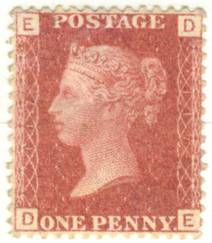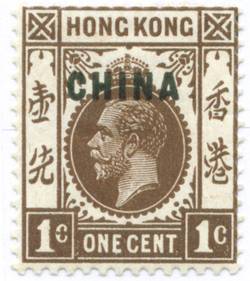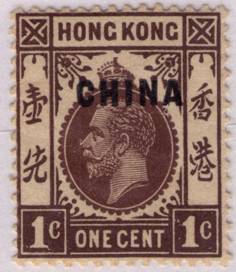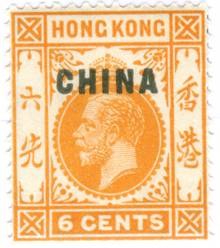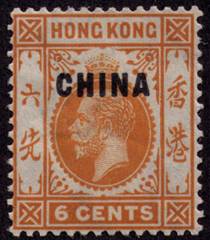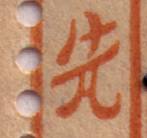Why the ‘China’ Overprints?
I began collecting stamps as a child, taking any stamps I could get my hands on, but as many people do, I lost interest and stopped collecting as a teenager. Years later, I was recovering from an accident and laid up in bed for about a month and I remembered the collection I had tucked away in a box and immediately my interest was sparked again. I was especially attracted to the stamps of my home country, England, that had been painstakingly hinged into a tattered old album. Once I was able to go out again, I located a stamp store close to my home and met the owners who helped give me a refresher course in stamp collecting.
Armed with a Scott catalog and supplies, including two brand new albums, one for Great Britain and one to contain all of my other stamps, I headed home to the beginnings of what became a lifelong passion. Within a month, my childhood stamps were resting safely in their new album and I was assiduously filling in all the empty spaces in my new Great Britain album.
I had attended a number of stamp shows and one afternoon, one of the dealers with whom I was chatting pulled out a $3 stamp which I immediately snapped up. I breathed a sigh of relief, knowing that finally, at least one part of my stamp album was going to be complete. At the same time though, there was a strange sense of loss; It was over, finished and done. I had the entire two sets and now I would have to think of some other area of my album to fill in.
However, as I was walking away from the table, a voice called me back over.
“Excuse me,” he said, “you’re interested in the British offices in China, are you?”
“Yes,” I replied, feeling rather good about having completed my collection.
“Well presumably you have this then?” Laying on the table in front of me was a stamp I thought I knew well, one of the first I had ever obtained. But something about it was just slightly different, “You have a copy of the Broken Crown then?” he asked.
“Broken Crown?” I replied.
“Yes”, he said, “the Broken Crown, it’s listed in Gibbons.”
“Gibbons?” I queried.
He explained to me that the Scott catalogue only listed the basics and pulled out a catalog I had never seen before. There, listed after Hong Kong was “China”, 27 stamps, however, listed below some of the numbers were letters; number 1 was the 1 cent brown, but listed below were “1a. Black Brown,” “1b Crown broken at right,” “1c Watermarked sideways,” and “1w Watermark inverted”. I realized I didn’t have all of the stamps, not by a long shot, my collection was not as complete as I had thought.
He recommended that I contact the APS for more information, I agreed and armed with both the elusive $3 stamp and this exciting new addition to my collection, I headed out.
Once I got home, I called the APS and explained that I was interested in the Hong Kong ‘China’ overprints and that I was looking for more information. A woman named Gini recommended Webb and Perrin and agreed to send me both. About a week later, two books arrived; the first was a large, imposing tome filled with page upon page of dense information, and the second was a thin book of only 44 pages with the cheery title “The Hong Kong ‘China’ Overprints” by K.L. Perrin.
I started to learn the story behind the stamps, I learned the history of the area and the reason that the stamps came into existence, but more than that, I learned how little I really knew.
There were not 27 stamps, there were 54, and there were not only more colors, there were dozens of varieties, there were stamps overprinted with ‘specimen’ instead of ‘China,’ there was stationery, there were postal cards and a news wrappers, there were different cancels from each of the treaty ports.
I had stumbled into something much larger that I had anticipated, a whole world about which I knew nothing, so much more than filling a few spaces in an album, but something that could occupy me for a long time to come.
I pulled out my album and mounted the two new stamps, not only were all of the spaces filled but I had added something to the page that didn’t originally have a space, that felt good. I looked closer at my original 26 stamps and noticed something I hadn’t before. On the 6c orange stamp, the lower left Chinese character had a bar connecting the two legs that was absent from all of the other stamps in my collection.
I pulled out the catalog and the books I had been sent, they didn’t show this. I called Gini back to ask her about it and she told me it was an unlisted variety, that people made new discoveries every day and there was always more to find.
I felt like I had been walking down a city street and, turning the corner, had not been greeted by another row of houses, but by an endless landscape stretching before me; the boundaries had changed. The catalogue was just the beginning, and it wasn’t complete. I had turned the corned and stumbled right into
something that changed the way that I looked at stamps forever, I was no longer a simple collector, I had started to become a philatelist.
